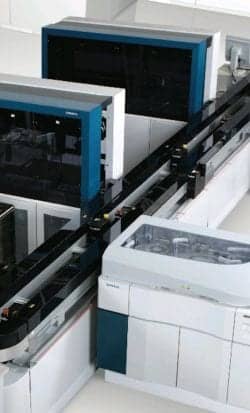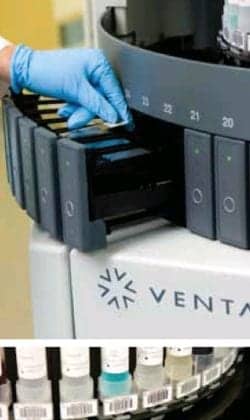
ThermoFisher Scientific PrintMate and CheckMate Cassette Printer
These are challenging times for clinical laboratories: health care reforms, a slow-to-recover economy, and a shortage in labor threaten viability. To survive, labs must streamline operations, maintain low operating costs, and increase diagnostic accuracy. In many cases, lab automation has not only helped labs survive these hard times, it has helped them thrive.
LAB AUTOMATION: A NECESSITY
Automation is essential if labs are to:
Stay competitive. Automation can help combat shrinking reimbursement rates, hospital and managed care budget cuts, and compensate for a diminished labor pool of qualified technicians.
Improve efficiency and consistency. Automation of diagnostics provides reliable and reproducible tests that manual testing by multiple technicians does not.
Increase productivity. Automated equipment can conduct multiple tests at once and often runs for extended periods without rest, providing for faster data collection. It can reduce sample bottlenecking by having a constant supply of samples to test.
Achieve financial stability, and possibly profitability. Manual testing requires more labor to manage the sample-preparation, testing, and validation processes; it can also introduce variability in results. Federal reimbursement is often denied for testing errors. Automating testing can help reduce errors, increase reimbursement, and reduce labor costs.
New Technologies

Siemens Healthcare Diagnostics’ ADVIA® Automation Solutions
There has been accelerated growth in automated lab technology over the last decade with more companies entering the market. Labs need to balance the ability to deliver fast, accurate test results while maintaining a consolidated workflow environment that maximizes throughput, reduces errors, and contains costs. “Advanced automation solutions enable laboratories to achieve this harmony by providing peak performance that helps meet turnaround time goals, process efficiency by reducing the number tubes and labor steps required in sample processing, access to an expansive test menu, the capacity for growth, and ultimately, improved confidence among laboratory staff,” says Dave Hickey, CEO, Chemistry, Immunoassay, Automation, and Diagnostics IT Business Unit, Siemens Healthcare Diagnostics, Deerfield, Ill.
Many labs run multiple analyzers and need a way to consolidate workflow among various systems through one solution. Automation helps reduce the number of samples sent out for analysis, helping labs consolidate more tests in-house, improve their service offering, and potentially improve income flow.
Trends in automation center around platforms that can help labs achieve an efficient, multidiscipline core lab that helps further reduce patients’ and physicians’ waiting times for lab results. With increased consolidation among independent labs and downward pressure on labs to fulfill bigger testing volumes with reduced staff, the best automation solutions grow with a lab’s needs, maintain consistent uptime, and fluidly perform during peak workloads.
A key development has been total tube management—ie, from the time a tube arrives in the lab to archiving. Labs expect automation systems to provide options to manage preanalytical and postanalytical processes more efficiently without compromising analytical performance. “A challenge can arise when a lab begins to seek out a system that fits the lab’s current needs, but can also continue to support the lab as the lab grows and its needs evolve,” Hickey says. Labs need to identify a company that offers automation solutions that can handle all parts of the lab’s life cycle. Another challenge can arise from a lab staff’s familiarity and acceptance of the system as a genuine efficiency tool. Proper consensus building, training, and support among staff members are essential.
The company’s multidiscipline automation solutions fit any size lab. Its tube-centric solutions ensure tubes spend as little time as possible getting to the analytical system or from analyzer to storage. Siemens’ ADVIA® Automation Solutions is a high-performance system that brings together advanced technology to create a single, consolidated platform. This multidiscipline system offers high capacity and increased throughput, and fully integrates with specimen processing management, centrifugation, and decapping. ADVIA offers more than 275 assays for screening, diagnosis, prognosis, and monitoring of most disease states.The company’s IT solutions work in tandem with its automation solutions, helping labs identify and implement process improvements that help improve efficiency (eg, through sophisticated and reliable autovalidation protocols), and quality.

Ventana BenchMark ULTRA
INTEGRATED HEMATOLOGY AND DIABETES TESTING
Sysmex America Inc, Mundelein, Ill, creates integrated automation systems platforms and components that communicate with one another, with other lab databases, and hospital electronic medical records. The company’s Lavender Top Management intelligent automation solution provides integrated hematology and diabetes automation testing and sample-management platforms. From a single EDTA (lavender top) vacutainer, a lab can conduct hematology (CBC, 7-part differential, automated digital cell morphology, fluorescent reticulocyte, automated and rapid ESR testing without consuming any sample), diabetes (HPLC HbA1c analysis), and esoteric tests (sickle cell, BNP, and folate).
The company’s automation platform (HST-N) with decision logic software, SYSMEX WAM enables the automation of preanalytical and postanalytical sample-management processes including sorting and archiving, and reflex/repeat testing. The automation platforms aim to minimize test tube touch points while maximizing the amount of clinical information from each lavender-top tube across the enterprise. This lavender top solution enables labs to realize virtually hands-free analysis of >90% high volume tests (CBC, Diff, Retic, HbA1c) and management of virtually 100% of EDTA tubes through sample rerouting and archiving, with as little human intervention as possible, the company says. This level of integration fosters efficiency in the management of the lavender top tube.
The company cites Islands of Automation as a new trend. The American Diabetes Association has recommended the use of HbA1c in the diagnosis of diabetes. Sysmex has collaborated with Bio-Rad Laboratories Inc, Hercules, Calif, to introduce an “island” that automates diabetes and hematology testing. The company says this first-of-its-kind solution, which combines the Sysmex HST-N hematology automation platform and the Bio-Rad VARIANT II TURBO Link, enables automated, on-demand, diabetes testing in a random access setting. By standardizing instrument platforms, information integration, and advanced technologies, labs can achieve unexpected levels of optimization for operations that help boost productivity.
INTEGRATED TECHNOLOGY FOR IMMUNOHISTOLOGY LABS
The discipline of histology is experiencing factors that drive the need for lab automation, says Andreas Kaepplein, Americas marketing manager, Thermo Fisher Scientific, Kalamazoo, Mich. Among them: the decline of certified histotechnologists—with fewer graduates entering the field of histology, and Baby Boomers retiring; an ever-growing workload due to an aging population; and patient safety issues. More labs are under pressure to provide a total chain of custody for specimen identification from the point where the specimen is taken from the customer to diagnosis to prevent misdiagnosis due to specimen mix-up.
Heightened awareness of health and safety issues due to cumbersome processes in the histology lab include repetitive motion or exposure to hazardous chemicals. “We are addressing these factors by providing automated solutions that enable customers to do more work with the same staff (eg, rapid turnaround time tissue processors, and automated slide stainers and coverslippers),” Kaepplein says. “We are also a market leader in patient identification solutions with our cassette and slide printing solutions (PrintMate and SlideMate); and a strong advocate for solutions that address health and safety needs with automated microtomes and cryostats (reducing carpal tunnel syndrome by reducing repetitive motion). We are also constantly developing new consumables that are less hazardous and packaging that reduces the exposure to hazardous chemicals.”
The company’s most popular automation solutions span many product lines. Its cassette and slide printing instruments can be found in labs worldwide. These instruments are typically used in a clinical environment where chain of custody of a patient specimen must be maintained. Thermo Fisher also offers solutions for immunohistochemistry that help smaller clinical lab operations to do cost-effective cancer diagnostics. “All of our products are used to diagnose tissue sections on a glass slide,” Kaepplein says. The final product can be reviewed by a pathologist. Many specialty disciplines within anatomical pathology routinely use the company’s instruments and consumables in clinical settings.
SOLUTIONS FOR ANATOMIC PATHOLOGY LABS
Automated lab solutions from Ventana Medical Systems Inc, Tucson, Ariz, a member of the Roche group, focus on tissue-based cancer diagnostics in the anatomic pathology laboratory. “Our product area focus is on immunohistochemistry (IHC), in situ hybridization (ISH), special stains, companion diagnostics, advanced workflow, and image analysis time, says Michael Sullivan, senior director, product marketing. “Our focus is on helping to bring about precise, personalized medicine in today’s histology labs.”
The company’s state-of-the-art automation offerings include the BenchMark XT and ULTRA platform series. The BenchMark XT automated slide preparation is a fully automated, random-access platform that allows clients to simultaneously run IHC and ISH tests and process patient cases. The system offers flexible, expandable tests menus, and is a connected workflow solution with LIS, central management, VIAS (an image analysis system), and VANTAGE connectivity (hardware, software, and workflow consulting designed for using Lean Six Sigma principles and includes support to help clients obtain immediate and ongoing workflow benefits).
“These connectivity solutions can increase lab productivity and reduce potential errors while eliminating over 80% of the labor required by staining-only slide systems,” Sullivan says. The BenchMark ULTRA system is the next generation in IHC/ISH staining instrumentation. Using 30 individual slide processors, its patient-centric workflow integrates continuous and random access for real-time STAT processing. “Turnaround times are significantly reduced, resulting in faster reporting of patient results and enabling the next generation in Lean laboratory workflow,” Sullivan says. Continuous and random access to 30 individual staining chambers permit labs to add and remove single slides, when needed, without interrupting workflow.
Fast turnaround time enables continuous processing and runs up to 30% faster than previous instrumentation generations. STAT samples can be added at any time, and samples can be added as needed so labs do not have to plan around batch cutoff times.
The intuitive, new software interface lets users see exactly when patient samples will be available. “We recently launched a digital pathology offering which is revolutionizing the ability to make tele- and digital pathology more broadly available in the anatomic pathology laboratory,” Sullivan says. “The iScan Coreo Au slide scanner provides high-speed brightfield slide scanning, improved image quality, and advanced slide handling. [It] is packaged with advanced image viewing software, offering pathologists and histotechnologists the ability to view and annotate digital images of scanned slides.”
iScan Coreo Au Live is a Web-based application designed to enable remote microscopy and live telepathology applications. Users can connect to the scanner from a remote location and review the slides within the system without being in the same location as the glass slide.
Transitioning manual lab functions to automated systems necessitates investment in capital for buying equipment, and investment in time for training personnel and obtaining lab accreditation, which can help labs realize savings over time.
Sarah Michaud is a contributing writer for CLP.





